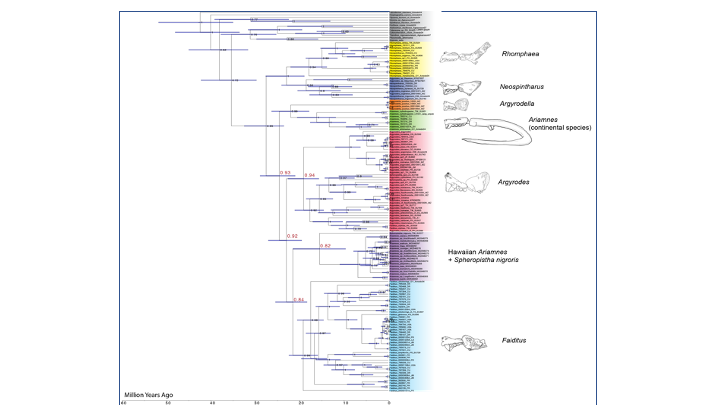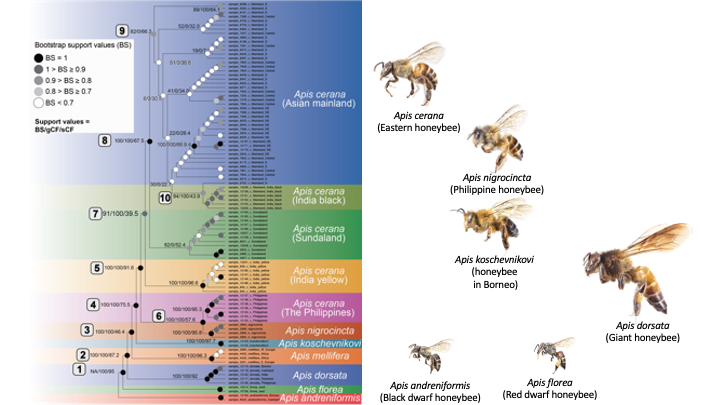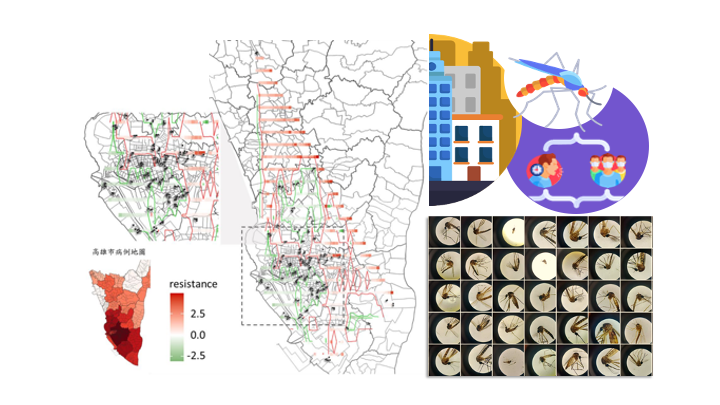基因體工具於演化生物學之應用
基因體工具於演化生物學之應用
本研究室的研究主軸是基因體及生物資訊方法,並高度整合族群遺傳、行為生態及田野生態學的理論,來測試演化上的各種假說。進入基因體時代後,本研究室進一步整合了基因體數據、生物資訊及機器學習的研究方法。初期研究為蜘蛛社會行為演化 (圖一) 。因此本研究室已經在本校生物醫學暨環境生物學系建立了一系列的基因體及生物資訊學所須的軟硬體設備。這些基因體的研究成果已經發表於國內外的研討會、受邀演講及數篇重要的著作。例如,由2022年(徐及蘇共同第一作者發表Systematic Biology (ranking <10% in Evolutionary Biology)。此篇論文應用最新的基因體目標定序法進行活化石節板蜘蛛演化假說的測試。此外是機器學習法研究社會型寄居姬蜘的行為演化(Su et al. 2021 in Mathematics, ranking <10% in Mathematics)。其他研究成果方面,有行為生態, 生物地理學, 族群遺傳及細菌基因體抗藥性演化。這些著作皆是應用生物資訊、數據科學及基因體學所得之成果。近一年來,本研究室也對蜜蜂(重要傳粉者)的演化(圖二)、高雄市病媒蚊的抗病毒研究等(圖三)皆是未來將有重要影響力的研究。

圖一:蜘蛛的社會行為演化

圖二:蜜蜂的基因體演化

圖三:病媒蚊的抗病毒特性研究
除了在校內的研究及合作已經有許多成果,在國際合作上,我聚焦在演化基因體學的應用及方法開發並與多國的學者合作。其中以東南亞的島嶼生物地理學為重點的領域。其中原因是因為東南亞島嶼為生物多樣性熱點,但其中的生物多樣性卻快速的消失。了解東南亞各地理區的遺傳、地理、物種的多樣性不僅是個人的研究興趣,這些地理區的生物多樣性改變及記錄也對整體環境變遷有著極高的重要性。自從2005年來,我已在東南亞的菲律賓、馬來西亞、新加坡及泰國進行長期的生物地理研究,並與美國、菲律賓、新加坡及泰國的圑隊合作。我們現也主導數個以蜘蛛、蜜蜂及兩爬類為主的東南亞生物地理學研究案。總結研究的成果:(1)本研究室的研究聚焦於重要的演化生物學議題。而且我們也已經建立了足夠人力、材料及背景資料以供後續的長期研究。(2) 本研究室的研究包括系統親緣學、分子生態學、行為生態學及生物地理學,並利用最新的基因體方法學。(3) 本研究室已經有足夠的經驗主導國際合作及正以研究室與國際圑隊合作。(4) 本研究室的近期著作皆發表於領域內國際重要期刊。
【研究團隊】
蘇詠超 副教授 及 生態與演化基因體學研究室
代表單位:高雄醫學大學生物醫學暨環境生物學系
圑隊簡介:生態與演化基因體學研究室以現代基因體學的工具研究生態、演化及其他生物學相關的問題。
電話:+886-7-3121101 轉 6983,email: ycsu527@kmu.edu.tw
【論文資訊】
論文出處:
1.Frontiers in Ecology and Evolution.:526
2.Systematic biology. 2021 Nov;70(6):1110-22.
全文下載:
1.https://www.frontiersin.org/articles/10.3389/fevo.2022.813777/full
2.https://doi.org/10.1093/sysbio/syaa098
Applications of Genomics Tools in Evolutionary Biology
Applications of Genomics Tools in Evolutionary Biology
The mainstream of our research is to test evolutionary hypotheses using genomic and bioinformatic methods with intensively integrating the theories in population genetics, behavioral ecology, and field ecology. In moving to genomic era, we have integrated the research approaches in genomics, bioinformatics, and machine-learning. Our earlier research focused on the social behavior and the evolution of spiders (Figure 1). We have established the genomic and bioinformatic facilities in the Department of Biomedical Science and Environmental Biology, KMU. The genomic research results have been presented at local and international conferences, invited conferences talks, and have resulted in several main publications. The first example is the the Xu, Su co-first authored, 2021 in Systematic Biology ( ranking <10% in Evolutionary Biology). This publication applied the most updated target genomic sequencing approach to answer the evolutionary hypotheses of a living fossil spider group. The second example is the the application of machine-learning approach for the ecological hypothesis of the social kleptoparasitic behavior in spiders (Su et al. 2021 in Mathematics, ranking <10% in Mathematics). Other than these publications, our publications in behavioral ecology, biogeography, population genetics, and the evolutionary genomics of the antibiotic resistance in bacteria. The research results have the applications of bioinformatics, data sciences, and genomics. During this year, we also developed the research outcomes in the honeybees (the most important pollinators) evolution (Figure 2) and the anti-virous properties of the disease vector mosquitos in Kaohsiung City (Figure 3), which are both expected to have high impact to these research fileds.

Figure 1. The social behavior and the evolution of spiders.

Figure 2. The genomic evolution of honeybees.

Figure 3. The anti-virous properties of the disease vector mosquitos in Kaohsiung City
While the research and collaboration at KMU has been fruitful, we are focusing on the method development and application of evolutionary genomics research and have been collaborating with international researchers. Specifically, island biogeography of SE Asia is an important field for me. It is simply because the SE Asian Islands are biodiversity hotspots yet the biodiversity in the region is quickly declining. The understanding of the genetic, geographic, species diversities in SE Asian Islands is not merely the personal research interest but also is of the importance of documenting and monitoring the changes of the biodiversity in this region. Since 2005, we have been conducting fieldwork and biogeographic research in the Philippines, Malaysia, Singapore, and Thailand with research teams from the USA, the Philippines, Singapore, and Thailand. We are leading several collaborative research projects using spiders, honeybees, and amphibian to study the biogeography of the Southeast Asian Islands. In summarizing our research achievements: (1) our research focused on testing conceptually intriguing, general-interest evolutionary hypotheses. And we have established enough team members, materials, and background information for our future long-term research. (2) We conducted empirical studies in phylogenetics, molecular ecology, behavioral ecology, and biogeography using up-to-date genomic methods. (3) We have the experiences in leading internationally collaborated research projects and have worked independently collaborate closely with different research groups in several countries. (4) We published our recent research results in high-ranking journals in our field.
Representative Department:
1.Yu CN, Lin HC, Kuo CY, Su YC. Foraging payoffs change with group size in kin and non-kin groups of a Argyrodinae kleptoparasitic spider, Argyrodes miniaceus. Frontiers in Ecology and Evolution.:526.
2.Xu X, Su YC, Ho SY, Kuntner M, Ono H, Liu F, Chang CC, Warrit N, Sivayyapram V, Aung KP, Pham DS. Phylogenomic analysis of ultraconserved elements resolves the evolutionary and biogeographic history of segmented trapdoor spiders. Systematic biology. 2021 Nov;70(6):1110-22.



